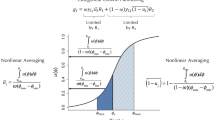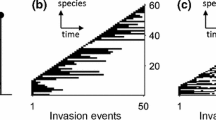Abstract
Although trade-offs are expected to play an essential role in shaping the diversity in a community, their effects remain relatively nebulous and notoriously difficult to assess. This is especially true when multiple trade-offs of different classes interact, a situation here designated by multidimensional trade-offs. When dealing with single trade-offs, some information can be predicted solely based on their curvature. Does this generalize to when dealing with multidimensional trade-offs? What happens if the trade-offs have opposing curvatures? To address these issues, we develop a resource-based model that encompasses multiple trade-offs mediated by the acquisition and processing of resources. Two distinct classes of trade-offs are assumed: (1) a trade-off among resource uptake rates, (2) a trade-off between the resource uptake rate and yield of the process of conversion of resource into energy. The model considers a spatially structured population of microbial organisms that grow on an arbitrary number of resources. These resources flow into the system at a constant rate and diffuse through the environment. The individuals can adopt a variety of strategies through mutation constrained by trade-offs, which renders the model adaptive. We assess population sizes and levels of ecological specialization. The analysis of the results reveals that when multidimensional trade-offs are considered the classical intuition stemming from single trade-offs does not hold. The outcome can depend significantly not only on the curvature of the trade-offs but also on resource availability.












Similar content being viewed by others
References
Amado A, Batista C, Campos PR (2018) A theoretical approach to the size-complexity rule. Evolution 72(1):18–29
Amado A, Campos PR (2017) The influence of the composition of tradeoffs on the generation of differentiated cells. J Stat Mech: Theory Exp 2017(6):063501
Bolnick DI, Yang LH, Fordyce JA, Davis JM, Svanbäck R (2002) Measuring individual-level resource specialization. Ecology 83(10):2936–2941
Boulangeat I, Lavergne S, Van Es J, Garraud L, Thuiller W (2012) Niche breadth, rarity and ecological characteristics within a regional flora spanning large environmental gradients. J Biogeogr 39(1):204–214
Broennimann O, Thuiller W, Hughes G, Midgley GF, Alkemade JR, Guisan A (2006) Do geographic distribution, niche property and life form explain plants’ vulnerability to global change? Glob Change Biol 12(6):1079–1093
Büchi L, Vuilleumier S (2014) Coexistence of specialist and generalist species is shaped by dispersal and environmental factors. Am Nat 183(5):612–624
Campbell M, Farrell S (2006) Biochemistry, 2nd edn. Cengage Learning, Boston
Chen Q, Wang G (2003) A class of bézier-like curves. Comput Aided Geom Des 20(1):29–39
de Oliveira VM, Amado A, Campos PR (2018) The interplay of tradeoffs within the framework of a resource-based modelling. Ecol Model 384:249–260
Devictor V, Clavel J, Julliard R, Lavergne S, Mouillot D, Thuiller W, Venail P, Villeger S, Mouquet N (2010) Defining and measuring ecological specialization. J Appl Ecol 47(1):15–25
Doebeli M, Dieckmann U (2003) Speciation along environmental gradients. Nature 421(6920):259
Edwards KF, Klausmeier CA, Litchman E (2011) Evidence for a three-way trade-off between nitrogen and phosphorus competitive abilities and cell size in phytoplankton. Ecology 92(11):2085–2095
Edwards KF, Stachowicz JJ (2010) Multivariate trade-offs, succession, and phenological differentiation in a guild of colonial invertebrates. Ecology 91(11):3146–3152
Egas M, Dieckmann U, Sabelis MW (2004) Evolution restricts the coexistence of specialists and generalists: the role of trade-off structure. Am Nat 163(4):518–531
Farahpour F, Saeedghalati M, Brauer VS, Hoffmann D (2018) Trade-off shapes diversity in eco-evolutionary dynamics. eLife 7:e36273
Farin G, Hoschek J, Kim M-S (2002) Handbook of computer aided geometric design. Elsevier, Amsterdam
Ferenci T (2016) Trade-off mechanisms shaping the diversity of bacteria. Trends Microbiol 24(3):209–223
Garland T (2014) Trade-offs. Curr Biol 24(2):R60–R61
Gavrilets S (2010) Rapid transition towards the division of labor via evolution of developmental plasticity. PLoS Comput Biol 6(6):e1000805
Ghoul M, Mitri S (2016) The ecology and evolution of microbial competition. Trends Microbiol 24(10):833–845
Gibbons SM, Gilbert JA (2015) Microbial diversity—exploration of natural ecosystems and microbiomes. Curr Opin Genet Dev 35:66–72
Guillaume F, Otto SP (2012) Gene functional trade-offs and the evolution of pleiotropy. Genetics 192:1389–1409
Hibbing ME, Fuqua C, Parsek MR, Peterson SB (2010) Bacterial competition: surviving and thriving in the microbial jungle. Nat Rev Microbiol 8(1):15
Hoyle A, Bowers RG, White A, Boots M (2008) The influence of trade-off shape on evolutionary behaviour in classical ecological scenarios. J Theor Biol 250(3):498–511
Ispolatov I, Ackermann M, Doebeli M (2012) Division of labour and the evolution of multicellularity. Proc R Soc Lond B Biol Sci 279(1734):1768–1776
Jessup CM, Bohannan BJ (2008) The shape of an ecological trade-off varies with environment. Ecol Lett 11(9):947–959
Kneitel JM, Chase JM (2004) Trade-offs in community ecology: linking spatial scales and species coexistence. Ecol Lett 7(1):69–80
Lancaster L, Hazard L, Clobert J, Sinervo B (2008) Corticosterone manipulation reveals differences in hierarchical organization of multidimensional reproductive trade-offs in r-strategist and k-strategist females. J Evol Biol 21(2):556–565
Leslie MP, Shelton DE, Michod RE (2017) Generation time and fitness tradeoffs during the evolution of multicellularity. J Theor Biol 430:92–102
Levins R (1962) Theory of fitness in a heterogeneous environment. I. the fitness set and adaptive function. Am Nat 96(891):361–373
Levins R (1968) Evolution in changing environments: some theoretical explorations, 2nd edn. Princeton University Press, Princeton
Litchman E, Edwards KF, Klausmeier CA (2015) Microbial resource utilization traits and trade-offs: implications for community structure, functioning, and biogeochemical impacts at present and in the future. Front Microbiol 6:254
MacLean RC (2008) The tragedy of the commons in microbial populations: insights from theoretical, comparative and experimental studies. Heredity 100(5):471–477
Maharjan R, Nilsson S, Sung J, Haynes K, Beardmore RE, Hurst LD, Ferenci T, Gudelj I (2013) The form of a trade-off determines the response to competition. Ecol Lett 16(10):1267–1276
Michod RE, Viossat Y, Solari CA, Hurand M, Nedelcu AM (2006) Life-history evolution and the origin of multicellularity. J Theor Biol 239(2):257–272
Novak M, Pfeiffer T, Lenski RE, Sauer U, Bonhoeffer S (2006) Experimental tests for an evolutionary trade-off between growth rate and yield in e: coli. Am Nat 168(2):242–251
Østman B, Lin R, Adami C (2014) Trade-offs drive resource specialization and the gradual establishment of ecotypes. BMC Evol Biol 14(1):113
Pease C, Bull J (1988) A critique of methods for measuring life history trade-offs. J Evol Biol 1(4):293–303
Pfeiffer T, Schuster S, Bonhoeffer S (2001) Cooperation and competition in the evolution of atp-producing pathways. Science 292(5516):504–507
Rockwood LL (2015) Introduction to population ecology. Wiley, Hoboken
Ryabov AB, Blasius B (2011) A graphical theory of competition on spatial resource gradients. Ecol Lett 14(3):220–228
Saeki Y, Tuda M, Crowley PH (2014) Allocation tradeoffs and life histories: a conceptual and graphical framework. Oikos 123(7):786–793
Shoemaker LG, Melbourne BA (2016) Linking metacommunity paradigms to spatial coexistence mechanisms. Ecology 97(9):2436–2446
Tikhonov M, Kachru S, Fisher D S (2019) Modeling the interplay between plastic tradeoffs and evolution in changing environments. BioRxiv, 711531
Velázquez J, Garrahan JP, Eichhorn MP (2014) Spatial complementarity and the coexistence of species. PLoS One 9(12):e114979
Weiner BG, Posfai A, Wingreen NS (2019) Spatial ecology of territorial populations. Proc Nat Acad Sci 116(36):17874–17879
Acknowledgements
PRAC acknowledges financial support from Conselho Nacional de Desenvolvimento Científico e Tecnológico (CNPq) under Projects Nos. 302569/2018-9 and 406594/2018-0. AA has a fellowship from the program PNPD sponsored by Coordenação de Aperfeiçoamento de Pessoal de Nível Superior (CAPES). The authors declare no conflicts of interest. This manuscript has previously been uploaded as a pre-print in biorXiv 492173; https://doi.org/10.1101/492173.
Author information
Authors and Affiliations
Corresponding author
Additional information
Publisher's Note
Springer Nature remains neutral with regard to jurisdictional claims in published maps and institutional affiliations.
Electronic supplementary material
Below is the link to the electronic supplementary material.
Rights and permissions
About this article
Cite this article
Amado, A., Campos, P.R.A. Ecological specialization under multidimensional trade-offs. Evol Ecol 33, 769–789 (2019). https://doi.org/10.1007/s10682-019-10013-4
Received:
Accepted:
Published:
Issue Date:
DOI: https://doi.org/10.1007/s10682-019-10013-4




